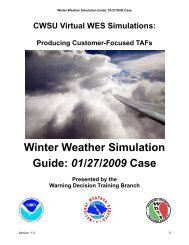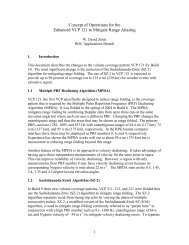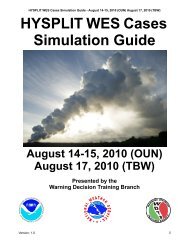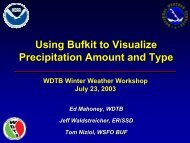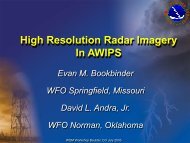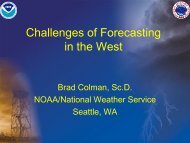Figure 12 - Reflectivity Continuity Over 6 TiltsThe Super Resolution algorithm has been designedto ensure that a sufficient number of samples areprovided for these, and other, critical functions. Thedesign provides the appropriate number of samples byactually acquiring the data over a 1.0 degree azimuthspan and then aggressively windowing the time seriesdata before computing the spectral coefficients. Withthis procedure, the effective beam width of the system,which is a combination of the antenna beam width andthe windowing function, can be reduced from about 1.4to 1.0 degrees (Torres and Curtis, 2006).The second aspect of Super Resolution and clutterfiltering is related to the clutter map generation andapplication. Super Resolution radials will be centeredon ¼ and ¾ degree marks of the fixed 720 one-halfdegree intervals. The non-super resolution data fromthe baseline ORDA are now centered on ½ degreemarks of the 360 one degree intervals. The existingclutter map generation and application process followsthe model of the baseline ORDA. Between SuperResolution and the baseline map model, there is a ¼degree offset in the radial centers. Because of thedistributed nature of most clutter, clutter map generationand registration with super resolution is not likely to be asignificant issue. However, the analysis teams willconduct testing to ensure this aspect does not affectproper filter application and the teams will makeadjustments to the mapping process, if needed.Staggered PRTThe ROC has recently begun the production designand implementation phase for the Staggered PRTrange-velocity ambiguity mitigation enhancement. Thistechnique employs non-uniform spacing of thetransmitted pulse in order to enhance separation of firstand second trip echoes. Because successive samplesare not spaced at equal time intervals, signal processingtechniques that rely on uniform sampling will not work.This includes GMAP. A new clutter filtering approach isneeded before Staggered PRT can be deployed.Fortunately, NSSL has developed a new clutterfiltering technique, which can be applied to StaggeredPRT (Sachindananda and Zrnic, 2006). ROC teammembers have begun plans for implementing andevaluating this filter as part of a phased development ofStaggered PRT. However, the first phase will feature asimpler filter based on a DC signal removal technique.Dual PolarizationThe exact impacts of dual polarization are not knownat this time, but it is likely some modifications to GMAPin the Dual Polarization mode will be needed. This willbecome necessary due to the need to carefully matchthe two channels of signal data. For example, theimpact of GMAP's signal rebuilding process on DualPolarization moment estimates is unknown and mayneed to be changed. Calibration for Dual Polarization isalso a challenge and some researchers have beenevaluating the use of ground clutter as a calibration aid.(Silberstein et. al., 2005, Zrnic et. al., 2006).8. MANAG<strong>IN</strong>G <strong>CLUTTER</strong> FILTER APPLICATIONThe judicious application of clutter filtering,appropriate for the conditions, is one of the moreimportant aspects of good radar data qualitymanagement. As seen in the examples here,inconsistent filter application, or rapidly changingpropagation conditions, can adversely affect dataquality. Teams at the ROC, NSSL and NCAR havebeen working to provide better tools for field operatorsto help them more effectively manage filteringoperations.Radar Echo Classifier (REC)The REC was the first clutter filter management toolto become available and has been a part of the <strong>WSR</strong>-
<strong>88D</strong> algorithm suite for some time (Kessinger et al.,2005). It consists of a fuzzy-logic based scheme thatuses the three basic radar moments as inputs. Thealgorithm delivers a product available to the operatorthat identifies probable areas of clutter for each volumescan. The operator can then choose to manually alterthe clutter filter settings to address the clutter. The RECdoes not incorporate any automated filter managementschemes, but does provide input for the precipitationalgorithms.Clutter Mitigation Decision (CMD)The next phase in clutter filter management willprovide for the automatic application of clutter filters inthe ORDA based on the CMD algorithm (Dixon et al.,2005 a, b). One problem with the use of spectral clutterfilters is that, as mentioned earlier, clutter in the spectraldomain looks very similar to stratiform precipitation witha narrow spectrum width and a velocity close to zero. Ifapplied everywhere, the filter will remove non-clutterpower from the weather signal in regions where theseconditions occur.In order to overcome this problem, it is necessary todeduce the likelihood of clutter, using informationindependent of that used by the filter. Examples of suchinformation are: (a) the spatial texture of the reflectivityfield, (b) the variability of the pulse-to-pulse power at agate (Tatehira and Shimizu, 1978), and (c) if dualpolarization data is available, the spatial variability ofDifferential Reflectivity (Z DR ) and Differential Phase(Φ DP ).The NCAR CMD uses this information, along withbase moments, to determine the likelihood of cluttercontamination for every bin. This clutter likelihoodparameter can then be used to update baseline cluttermaps, automatically applying filtering to bins whichbecome contaminated by clutter due to changingpropagation conditions. The ROC has begun designingthe production implementation of the NCAR CMDalgorithm with deployment currently scheduled forsoftware Build 13.0.To support early evaluations and production designanalysis, ROC Engineering implemented the NCARalgorithm in MATLAB (Warde et. al., 2007). Using timeseries data from normal <strong>WSR</strong>-<strong>88D</strong> scans, the MATLABtool can produce a clutter map which can be applied inthe laboratory to an RVP8 when the same time seriesdata set is played back to produce Level 2 momentestimate data.Figure 13 shows the results of an early analysis onthe performance of the laboratory CMD tool. Note thatthe clutter map and the radar data image are not to thesame scale. On the left side (a), upper panel, is aclutter map generated via the normal <strong>WSR</strong>-<strong>88D</strong> radartest software suite. Below that is a correspondingreflectivity image processed from time series data andusing that normally generated map to apply clutterfiltering. This clutter map was generated by the RadarSystem Test Software (RSTS) mode on the live radarand uses a special scan which ensures high resolutionof clutter returns. It must be run during specific weatherconditions. The data set shown was known to containAP clutter. As can be seen, applying a normalpropagation map to AP-clutter contaminated dataresults in poor filtering of the AP-clutter.The upper right panel of Figure 13, shows a mapgenerated by CMD from the same set of data. The mapis the output of a MATLAB based analysis tooldeveloped by ROC Engineering from the algorithmdescription provided by NCAR. The CMD map isgenerated from the time series data using anoperational VCP. The reflectivity estimate field shownbelow the map was produced using the same timeseries data set, but with the CMD map determining filterapplication. As can be seen, the CMD-controlled filterapplication eliminates the AP-clutter and cleans up thedisplay.ROC engineers continue to develop tools for theCMD project and will address specific implementationdesign details in the coming year. Some aspects of theproduction design will include decisions about the needfor real-time bin-by-bin determination of clutter filtercontrol. It may be that the most efficient implementationwill be to use CMD to update the system clutter mapseach VCP, rather than on the fly for every data bin. Thedesign team will conduct the necessary trade-offanalysis and will validate the selected approach usingthe laboratory playback and analysis tools on radar timeseries data.NCAR scientists are also improving the CMD design,adding new inputs and streamlining the requiredprocessing which will ease implementation into theORDA signal processing functions.9. CONCLUSIONWith the completed deployment of the ORDA inOctober 2006, many new options for radar performanceenhancement are now possible. An important aspect ofthese new capabilities is the optimization of clutterfiltering. Early experience with the ORDA has led tosome near-term improvements such as adjustment ofthe GMAP clutter spectrum width parameter and theaddition of multiple map segments.ROC team members, from both the scientific andengineering disciplines, plan to continue efforts tomonitor clutter filter performance and will work to identifyand implement additional improvements. The teams willcontinue to optimize the integration of clutter filteringinto new science enhancements as they are approvedfor the <strong>WSR</strong>-<strong>88D</strong> network. The addition of CMD to thesystem will provide a significantly enhanced capability tomanage the filtering process.10. ACKNOWLEGEMENTSThe authors would like to acknowledge the supportprovided by their organizations, the Radar OperationsCenter, the National Severe Storms Laboratory, and theNational Center for Atmospheric Research.Finally, the authors would like to thank all the <strong>WSR</strong>-<strong>88D</strong> field radar operators for their feedback during theORDA deployment. Examples of system performancesuch as those presented here were extremely helpful in





